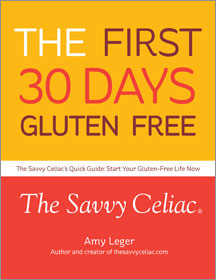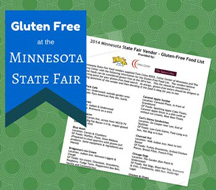It’s hard to imagine. In six years my celiac daughter, Emma, will go to college — living a gluten free life away from her sheltered little gluten free cocoon we’ve put together for her. Yes, someday I will need to stop being the go-to gluten-free food encyclopedia and trust that she can keep herself healthy.
Six years may seem like forever away, but before I know it, it will be here. And what will we have taught her?
Top 10 Tips to Empower a Gluten Free Child
These are in no particular order– some may be big picture, some may be very specific, but I hope by the time “we’re done with her” she’ll be ready to face the world as a strong gluten-free woman.
1. Speak up when something’s not right. This goes for many things in life actually, but when it comes to celiac disease, not speaking up could make you sick. So far, this has been a challenge, Emma isn’t even correcting her teachers who are mispronouncing her last name (it’s Lezh-AY, not LEG-ger, LEE-ger, or LEDG-er). But we continue to work on it.
2. Know your ingredients. This goes for gluten free and gluteny ingredients. She needs to be able to look at a label and based on that, decide of she can have it. She did this for the first time with a “Fudgesicley” ice cream treat on Tuesday– with success. She’s 12, so I am happy to see signs of her taking control.
3. Don’t let another adult try and tell you differently. I find even adults my age, younger and older try to explain gluten free to me and they sell it like they have experience, when in actuality, they only know a small amount or nothing at all. These could be sales people, friends’ parents, or even a restaurant server. Don’t let these people steer you away from what you know. If in doubt, don’t eat it.
4. Learn how to tactfully turn people down when they offer food. You can go with the truth, “I can’t eat it if it’s not gluten free” (this can be turned into an educational opportunity). Or perhaps a white lie, “I already ate, thanks for offering”.
5. Learn how to manage that dreaded pizza party. How many times in high school or college did YOU order pizza after a basketball game or on a Friday night with a group of friends? Exactly. It’s a whole new challenge for gluten-free kids– one we haven’t had to deal with yet.
Sure, Emma’s gone to birthday parties where there is pizza, but when you’re younger, I (still) call the mom, find out what they’re eating, I bring something for Emma that she likes better than pizza and we’re all good. But when she’s 17 or 21 and everyone’s going out for pizza, she will have to make the decision to speak up (see #1) or just let it go and not eat or even worse, eat the gluteny pizza and get sick? If she speaks up, what does she say? “I can’t eat there, let’s go to another place with gluten free pizza”? Or does she say, “Let’s just go to my house and find something there”? Since that is one we still have to conquer…feel free to leave comments/tips below with your suggestions on what you or your child has done.
6. Be grateful to people who try to accommodate your gluten-free needs. There are times where people will go out and buy gluten-free food for you or even try making something. How do you respond? We’ve been working on this for a few years with Emma. If you deem it safe, eat it. I don’t care if it’s something you wouldn’t normally eat– try it and be very verbal in your thank yous. It takes a lot for people to accommodate gluten-free diets. If you deem it unsafe, then that’s tricky. Be grateful that they tried and tell them thank you. But find a way not to eat it. If you can explain to the host why you can’t eat it (without insulting them of course), that is the best way to go.
7. Plan and work through a weekend (or weeklong) trip with a friend’s family. Kids get invited to go to cabins, vacation homes, weekend trips with their friend’s families all of the time. So how will the gluten free child handle organizing it with the friend’s family? Well that can be tough. Emma already has some friends whose parents have learned how to feed her. Some always have certain treats on hand that they know Emma can have. Which is awesome! Others may not know much about gluten-free diets, cross contamination and how sick she can get.
I think the best way here (if I or my husband isn’t getting involved), is to talk with your friend about your concerns and then two of you go and talk to the parents together about accommodating the gluten-free diet (see what they’re bringing, volunteer to bring supplements you can eat, find out if there will be any dining out). If the parents you talk to aren’t getting it….that’s when I would hope the child (in our case, Emma) would choose not to go.
8. Learn how to shop with gluten-free smarts. I am only in the early stages of this Emma. It is cheaper and healthier to choose fruits, vegetables, and fresh meats at the grocery store..they’re naturally gluten-free! But what about those breads and fun gluten-free treats like cookies and cake? Well it’s least expensive to buy the ingredients and make it. Plus you have control over the ingredients — you can make it healthier and better tasting with some great whole grain gluten free flours that are available. If that’s not possible, buying several items at one time (ie through Amazon or other online retailers) is a good way to save money on gluten-free foods.
9. Get COOKING! My daughter doesn’t have an interest here, plus I am a control freak. So this is a challenge for me. But she MUST learn how to cook for herself. Buying those processed foods are so bad for all of us. This needs to be a priority.
10. Have Fun; Enjoy Being Healthy! We know it is tough managing a diet at the age of 12 or 17 or even 23! Especially when you see all your friends eating whatever they want. My suggestions to my daughter would be: always have a stash of your favorite gluten free foods (hers would be popcorn and cereal), learn ways to make your cooking taste like the best thing ever, and …uh…don’t kiss a boy who just ate gluten… 🙂 Just had to add that in there…..
Good luck in preparing your celiac child for life. If you have some real-life examples we can learn from please comment below.
Tags: celiac, children, cooking, diet, gluten-free, shopping



June 30th, 2011 at 7:42 am
Great post, Amy! My kids are 7, 7 & 4, so I have a little while longer to go before having to deal with this. But thinking about my daughters out in the world, eating without me there (I’m a control freak, too), terrifies me! I think the reason I’m the most worried is because I know what I was like when I left home; I ate whatever I wanted, no matter what. My parents weren’t as knowledgeable as you & I are, so they didn’t prepare me the way they should have. Still, it takes a lot of willpower to stick to your guns when all your new friends are doing something that you *so much* want to be a part of. I just hope that by the time our daughters are college-age, there will be more options for them!!! Thanks for posting this list, it gives me a lot to think about!
June 30th, 2011 at 8:23 am
I was the child…for me, what worked was for my parents to let go and let me learn. I thought I knew best (most 12 year olds do)and one summer at camp I decided I was going to eat whatever I wanted. This of course was a really really bad idea. I was sick enough half way through the week that I could have died (multiple food allergies on top of CD). After that week was much more careful about what I ate. In fact, I became more careful than my parents about it.
I’ve talked to my parents about it some since then and they said it was real hard to let me go knowing that I would likely make poor choices, but it was a very powerful learning experience for me. And because I was 12, I was old enough that I was going to remember it for a good long time.
June 30th, 2011 at 10:40 am
Amy,
thank you for summing up this terrific conversation starting list for a gluten free child.
Our daughters are 12 as well, can’t imagine them leaving the house either.
But it is just 5 or 6 years till college!
One other area that needs to be talked about early, especially with kids is makeup and kissing.
The average woman eats 7 pounds of lipstick over a lifetime. So when our gluten free daughters start to wear it, we have to advocate for a gluten free choice right from the start
And for both sexes, we have to have a conversation about when it is safe to share a kiss.
After all, even if my daughter doesn’t eat the pizza if her kissing partner to be does, she will still get sick.
And if a boy kisses a girl with gluten full lipstick on, the boy can end up with a reaction.
Humor is essential here but it needs to be shared, no pun intended.
June 30th, 2011 at 10:38 pm
Great post full of lots of things to think about. My gluten-free girls are only 8 but have already faced a number of the above scenarios in a good way. It will be interesting as their freedoms grow as they get older (time away from the family spent at friends’ houses, etc), to see how we end up dealing with their diet.
One thing we did which helped them learn how to read labels and ingredients better was spending some time in our grocery store, just going through the aisles and looking at a bunch of different sections. We went through many areas and talked about which foods are GF or not, and how to tell. We looked for the words “gluten free” and the “contains ___ allergens” in bold after ingredients, etc. I found they were confused by terms like “whole grain” which they immediately thought meant gluten. So, it was fun and educating at the same time….for all of us. My daughters learned a lot that day and love to read labels now to figure things out for themselves.
Hopefully I’ll have the same luck as they age! 😉
July 3rd, 2011 at 1:03 pm
Oh my, I am so glad I fell upon this post! And the comments that go with it 🙂 My son is about to start school and I realize it’s opening up a whole new chapter to our lives. Thank you so much for posting this, and thank you to everyone for the additional info in the comments.
July 3rd, 2011 at 4:46 pm
That is a great list of advice and tools to help children live with their gluten sensitivities. The more repetition we do in teaching our children (about anything!), the better understanding they will have on how to cope and deal with their (medical or otherwise) problems.